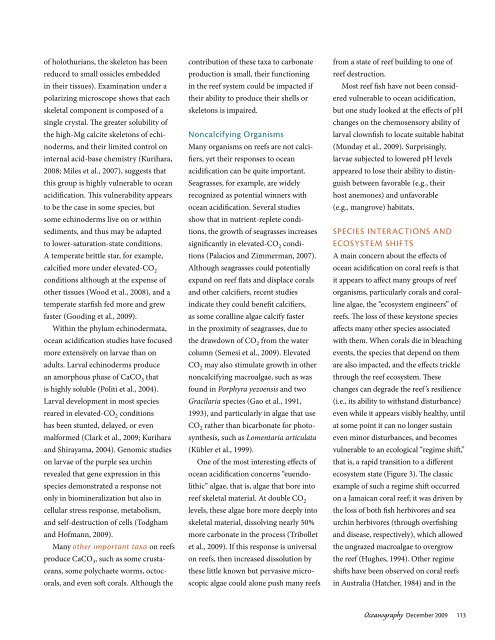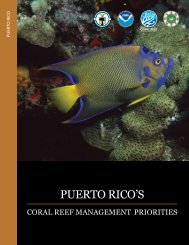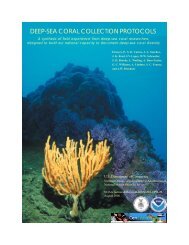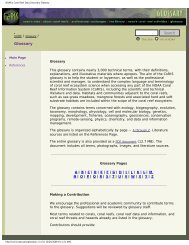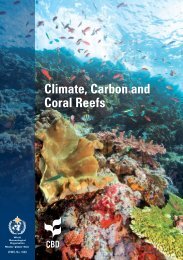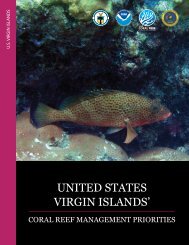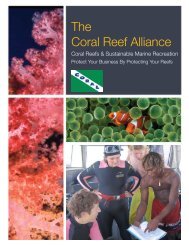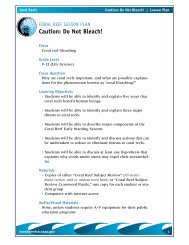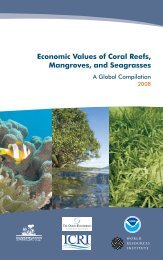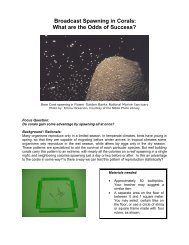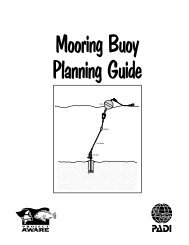coral reefs and Ocean acidification
coral reefs and Ocean acidification
coral reefs and Ocean acidification
Create successful ePaper yourself
Turn your PDF publications into a flip-book with our unique Google optimized e-Paper software.
of holothurians, the skeleton has been<br />
reduced to small ossicles embedded<br />
in their tissues). Examination under a<br />
polarizing microscope shows that each<br />
skeletal component is composed of a<br />
single crystal. The greater solubility of<br />
the high-Mg calcite skeletons of echinoderms,<br />
<strong>and</strong> their limited control on<br />
internal acid-base chemistry (Kurihara,<br />
2008; Miles et al., 2007), suggests that<br />
this group is highly vulnerable to ocean<br />
<strong>acidification</strong>. This vulnerability appears<br />
to be the case in some species, but<br />
some echinoderms live on or within<br />
sediments, <strong>and</strong> thus may be adapted<br />
to lower-saturation-state conditions.<br />
A temperate brittle star, for example,<br />
calcified more under elevated-CO2 conditions although at the expense of<br />
other tissues (Wood et al., 2008), <strong>and</strong> a<br />
temperate starfish fed more <strong>and</strong> grew<br />
faster (Gooding et al., 2009).<br />
Within the phylum echinodermata,<br />
ocean <strong>acidification</strong> studies have focused<br />
more extensively on larvae than on<br />
adults. Larval echinoderms produce<br />
an amorphous phase of CaCO3 that<br />
is highly soluble (Politi et al., 2004).<br />
Larval development in most species<br />
reared in elevated-CO2 conditions<br />
has been stunted, delayed, or even<br />
malformed (Clark et al., 2009; Kurihara<br />
<strong>and</strong> Shirayama, 2004). Genomic studies<br />
on larvae of the purple sea urchin<br />
revealed that gene expression in this<br />
species demonstrated a response not<br />
only in biomineralization but also in<br />
cellular stress response, metabolism,<br />
<strong>and</strong> self-destruction of cells (Todgham<br />
<strong>and</strong> Hofmann, 2009).<br />
Many other important taxa on <strong>reefs</strong><br />
produce CaCO3 , such as some crustaceans,<br />
some polychaete worms, octo<strong>coral</strong>s,<br />
<strong>and</strong> even soft <strong>coral</strong>s. Although the<br />
contribution of these taxa to carbonate<br />
production is small, their functioning<br />
in the reef system could be impacted if<br />
their ability to produce their shells or<br />
skeletons is impaired.<br />
Noncalcifying Organisms<br />
Many organisms on <strong>reefs</strong> are not calcifiers,<br />
yet their responses to ocean<br />
<strong>acidification</strong> can be quite important.<br />
Seagrasses, for example, are widely<br />
recognized as potential winners with<br />
ocean <strong>acidification</strong>. Several studies<br />
show that in nutrient-replete conditions,<br />
the growth of seagrasses increases<br />
significantly in elevated-CO2 conditions<br />
(Palacios <strong>and</strong> Zimmerman, 2007).<br />
Although seagrasses could potentially<br />
exp<strong>and</strong> on reef flats <strong>and</strong> displace <strong>coral</strong>s<br />
<strong>and</strong> other calcifiers, recent studies<br />
indicate they could benefit calcifiers,<br />
as some <strong>coral</strong>line algae calcify faster<br />
in the proximity of seagrasses, due to<br />
the drawdown of CO2 from the water<br />
column (Semesi et al., 2009). Elevated<br />
CO2 may also stimulate growth in other<br />
noncalcifying macroalgae, such as was<br />
found in Porphyra yezoensis <strong>and</strong> two<br />
Gracilaria species (Gao et al., 1991,<br />
1993), <strong>and</strong> particularly in algae that use<br />
CO2 rather than bicarbonate for photosynthesis,<br />
such as Lomentaria articulata<br />
(Kübler et al., 1999).<br />
One of the most interesting effects of<br />
ocean <strong>acidification</strong> concerns “euendolithic”<br />
algae, that is, algae that bore into<br />
reef skeletal material. At double CO2 levels, these algae bore more deeply into<br />
skeletal material, dissolving nearly 50%<br />
more carbonate in the process (Tribollet<br />
et al., 2009). If this response is universal<br />
on <strong>reefs</strong>, then increased dissolution by<br />
these little known but pervasive microscopic<br />
algae could alone push many <strong>reefs</strong><br />
from a state of reef building to one of<br />
reef destruction.<br />
Most reef fish have not been considered<br />
vulnerable to ocean <strong>acidification</strong>,<br />
but one study looked at the effects of pH<br />
changes on the chemosensory ability of<br />
larval clownfish to locate suitable habitat<br />
(Munday et al., 2009). Surprisingly,<br />
larvae subjected to lowered pH levels<br />
appeared to lose their ability to distinguish<br />
between favorable (e.g., their<br />
host anemones) <strong>and</strong> unfavorable<br />
(e.g., mangrove) habitats.<br />
SpecieS iNter actiONS aNd<br />
ecOSyStem ShiFtS<br />
A main concern about the effects of<br />
ocean <strong>acidification</strong> on <strong>coral</strong> <strong>reefs</strong> is that<br />
it appears to affect many groups of reef<br />
organisms, particularly <strong>coral</strong>s <strong>and</strong> <strong>coral</strong>line<br />
algae, the “ecosystem engineers” of<br />
<strong>reefs</strong>. The loss of these keystone species<br />
affects many other species associated<br />
with them. When <strong>coral</strong>s die in bleaching<br />
events, the species that depend on them<br />
are also impacted, <strong>and</strong> the effects trickle<br />
through the reef ecosystem. These<br />
changes can degrade the reef ’s resilience<br />
(i.e., its ability to withst<strong>and</strong> disturbance)<br />
even while it appears visibly healthy, until<br />
at some point it can no longer sustain<br />
even minor disturbances, <strong>and</strong> becomes<br />
vulnerable to an ecological “regime shift,”<br />
that is, a rapid transition to a different<br />
ecosystem state (Figure 3). The classic<br />
example of such a regime shift occurred<br />
on a Jamaican <strong>coral</strong> reef; it was driven by<br />
the loss of both fish herbivores <strong>and</strong> sea<br />
urchin herbivores (through overfishing<br />
<strong>and</strong> disease, respectively), which allowed<br />
the ungrazed macroalgae to overgrow<br />
the reef (Hughes, 1994). Other regime<br />
shifts have been observed on <strong>coral</strong> <strong>reefs</strong><br />
in Australia (Hatcher, 1984) <strong>and</strong> in the<br />
<strong>Ocean</strong>ography december 2009 113


